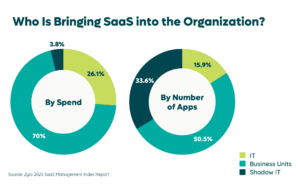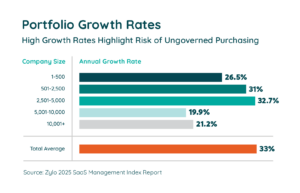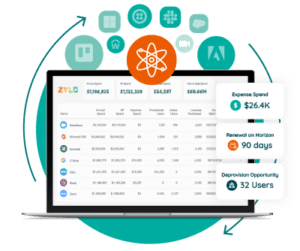Table of Contents
The use of SaaS has spiked over the last decade and will continue to rise exponentially in the coming years. Gartner projects that SaaS spending is will grow 19% to total $299B in 2025. And SaaS spending is expected to climb 15-20% annually.

The accessibility of such applications and their utility have made them a go-to for many organizations for their day-to-day software solutions. However, the proliferation of SaaS has created a problem for many companies.
Many organizations have become oversaturated with redundant and abandoned SaaS applications. Whenever your organization has too many apps, financial and security risks grow exponentially. Knowing when you have too many apps and how to reduce them when needed is imperative for any organization.
How Many Apps Are Too Many?
Zylo’s SaaS Management Index report showed that organizations often underestimate the number of applications they use by 1.7X and spend by 3X. This is in part because IT now only manages, on average, 16% of an organization’s SaaS.
 That means the remaining 84% is being managed and purchased by business units and individual employees. The repercussion of this is that it becomes difficult for IT teams to manage and optimize their organizations’ SaaS assets.
That means the remaining 84% is being managed and purchased by business units and individual employees. The repercussion of this is that it becomes difficult for IT teams to manage and optimize their organizations’ SaaS assets.
The average organization has approximately 275 SaaS applications. For large organizations, this number skyrockets to an average of 660.

What’s more, our research has shown that the average organization adds approximately seven new SaaS applications every 30 days. Over the course of a year, that adds up to 91 new applications, or 33% portfolio growth.

With numbers like these, it is no wonder that tracking down all the applications and their relevant information has become taxing for IT. New SaaS applications frequently appear and fall into disuse before IT can achieve full SaaS visibility.
That is why SaaS discovery tools like Zylo are necessary to push that push boulder up the digital mountain and keep it there.
Although there is certainly no limit to the number of SaaS applications a company can utilize, too many apps often bring serious consequences.
More Apps Mean More…
Renewals
As the number of SaaS applications increases in an organization, so too do the challenges of maintaining an effective SaaS renewal process. That can become frustrating as companies experience an average of 247 renewals a year. That is nearly one renewal per business day! With too many apps, it becomes difficult for an organization to achieve total visibility into all SaaS spending.

Visibility is necessary to provide benefits such as:
- The ability to plan for renewals – By knowing what SaaS the entire organization uses, you can examine their usage and determine whether renewal is desirable. Otherwise, the time for renewal comes around and you have no idea whether the cost is worth it.
- The ability to share application recommendations across organizations – Using a complete view of SaaS, organizations can standardize lists of applications for different stacks. This can reduce or eliminate redundant functions while also bringing down the number of renewals to manage.
- The ability to forecast budgets by department – Accurate historic data allows finance to predict budget changes before renewals come around.
That is why it is essential to adopt SaaS renewal best practices. Good approaches provide this visibility and establish a proactive approach to managing renewals.
Redundancy
Any organization that finds itself with too many SaaS applications will inevitably encounter redundancy.
Redundant SaaS applications are when multiple programs fulfill the same function within an organization. While the business can subsist on just one of them, they pay for both.
Redundant apps deprive organizations of purchasing power, dividing tech investment budgets across several apps serving the same function. This often occurs when organizations fail to implement effective SaaS management practices.
 Organizations should work to merge these redundant applications to a single standard. This singular application for all users across the organization will save the company untold costs. Not only does this reduce investment costs, but also creates easier and stronger collaboration.
Organizations should work to merge these redundant applications to a single standard. This singular application for all users across the organization will save the company untold costs. Not only does this reduce investment costs, but also creates easier and stronger collaboration.
Of course, this isn’t always the case. It is important to note that redundancy is sometimes tolerable or even necessary.
For example, you may find that product A offers effective workflow tools for the IT stack while product B solves the same problem for the marketing stack. At the same time, product B may have the right tools integrated to better serve its function in that stack.
Luckily, SaaS management tools like Zylo offer essential tools to discover redundancy and determine when it needs addressing.
Contract Negotiation Opportunities
Organizations face a challenge when it comes to SaaS contract negotiation.
Employee-acquired applications often exist unbeknownst to IT. Lack of visibility means they are more likely to rely on click-through license agreements rather than a negotiated enterprise contract. The latter of these offers organizations significantly more protection than the former. They are also difficult to discover.
That is why the first and most essential step for managing SaaS contracts is creating a singular, holistic view of SaaS across an organization.
Negotiating enterprise contracts offers several advantages:
- Consolidating contracts consolidates purchasing power. Organizations can save money by merging multiple instances of employee-acquired SaaS applications into a singular enterprise-grade application with multiple seats.
- Enterprise contracts offer security and compliance. Negotiating an enterprise contract allows an organization concerned about security and compliance with privacy regulations to add clauses not available in click-through agreements.
- Avoiding click-through terms. Employee-led SaaS acquisition can hold an entire organization to a single click-through agreement. These default agreements often favor the vendor. Thus, negotiating enterprise SaaS contracts is necessary to ensure fair terms with a vendor.
And these are only some of the benefits of proper SaaS contract management.
The SaaS Management Lifecycle
Managing your SaaS is an ongoing process. The SaaS Management Lifecycle is a process that enables you to systematically discover the apps you have. From there, you can identify whether you have too many, and rationalize and optimize what you have.
Here’s more information on the different stages of the SaaS Management lifecycle:
Discover
 The bedrock of SaaS Management is inventory management, which is founded on discovery. By using SaaS discovery, a company can determine how many applications they have, and how much they are spending. As most organizations underestimate both, it is important to begin here with a powerful discovery tool. Zylo provides just the Discovery Engine you need to do just that.
The bedrock of SaaS Management is inventory management, which is founded on discovery. By using SaaS discovery, a company can determine how many applications they have, and how much they are spending. As most organizations underestimate both, it is important to begin here with a powerful discovery tool. Zylo provides just the Discovery Engine you need to do just that.
Optimize
Once discovered, the next step is to determine which applications should remain in use. It is more than an audit. It determines the use and reason for each tool in the SaaS stack.
This process of application rationalization or, determining where you can consolidate is the first step. The second is the optimization of all available SaaS applications, eliminating legacy systems, replacing sunsetting tools, and saving costs.
The result is a leaner, more efficient SaaS stack.
Plan with Proactive Renewal Management
The key to good renewal management is knowing how many licenses you need, what type, and how your price compares to your peers.
Zylo can help you answer all of these questions, and help you track your renewals 30-90 days in advance so you can prepare.
For more information, read our guide to SaaS renewals.
The Ultimate Guide for Wildly Effective SaaS Renewals
Learn MoreGovern
SaaS governance helps identify, control, manage, and mitigate security and compliance risks. With a cloud governance framework in place, businesses are enabled to create a process for vetting new purchases
Without a clear intake process, shadow IT and redundant applications can grow quickly in an organization. Worse yet, applications that do not go through formal vetting pose threats to security and compliance. In 2024 alone, data breaches cost companies an average of $4.88M.
With Zylo, you can better understand SaaS purchasing hygiene habits, and how you can manage them.
SaaS Management Is Key to Reining in Too Many Apps
The proliferation of apps has created the need for consistent and effective SaaS management. Without it, inefficiencies from across the organization harm the bottom line and employee effectiveness. Not to mention, they open your company to potential security and compliance risks.
Luckily, Zylo is here to help. Our SaaS visibility and inventory management tools can empower your business to manage the complicated swarm of applications with ease. Our platform will find all of your SaaS–wherever it may be hiding–and provide you with all the information you need to manage it.
Don’t let your applications eat away at your bottom line. Schedule a demo with us today and take a peek at the ways we can streamline your business and save you money and time.

